|
October, 2007
Thanks to my lovely friend, Deb, for supplying me this information. |
|
A New Series by
REUBEN FINE
The Great
MASTERPIECES
OF CHESS
Grandmaster Reuben Fine presents his own selection of outstanding chess
classics. The background of each memorable encounter is described and the
game fully explained. This monthly series is published by special
arrangement with the author and with the David McKay Co Philadelphia, who
will publish 100 of these games in book form.
|
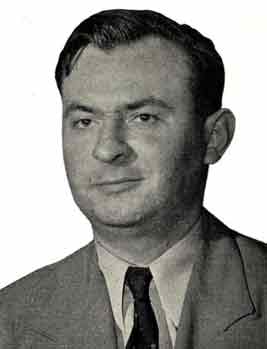 |
4. PAUL CHARLES
MORPHY Morphy is unique.
In little more than a rear he became world champion by beating almost all
his serious
competitors----a feat which has never been equaled. More important, in a
sense, is the fact that millions since have looked upon him as the greatest
and most brilliant master of all time, the champion of champions.
Paul Charles Morphy was born in New Orleans June 22, 1837, of a Spanish
Irish father and a French Creole mother. Both his father and his uncle were
enthusiastic chess players and at ten Paul was taught the moves. In two
brief years he had improved so incredibly that he not only beat everybody in
sight, but also defeated the well
known expert L÷wenthal during a visit to New Orleans. Morphy is one of the
three chess boy wonders who have become eminent in later life the other two
are Capablanca and Reshevsky.
School absorbed his attention until 1857, when
he received a degree in law. Too young to practice in his native city, he
devoted his time to travel and
chess. First stop was the American championship at New York, in 1851. There
were sixteen competitors, mostly mediocrities, but one, Louis Paulsen, was
among the strongest alive. Morphy won decisively. Then in June, 1858, he
went to England, where he announced his willingness to play a match with any
first class master. Money was no object, for his family was wealthy,
Staunton was then English chess. Morphy's eagerness to meet Staunton,
however, was matched only by the Englishman's desire to avoid a serious
encounter, and a match could never
be arranged. Morphy had to content himself with beating everybody else in
sight, including his old antagonist L÷wenthal. His superiority was so
crushing that he gave Rev. Owen odds of Pawn and move and did not lose a
single game. From England Morphy went to Paris where he first swept Harrwitz
out of the way and then in December, 1858, turned his attention to
Anderssen, winner of the first modern tournament, at London in 1851, and
generally regarded as the foremost master of the day. Again Morphy scored a
crushing victory.
At 21 Morphy was undisputed champion of the world. Back in New York, he was
wined and dined. To his fellow Americans he was the hero of the hour, Here,
inexplicably, the epic march 10 glory ends, and the tragedy begins. After
the Anderssen victory, except for a minor match with Mongredien, Morphy
withdrew completely from serious chess. Steinitz, Kolisch, Zukertort,
Blackburne appeared while he was still young and healthy, but Morphy merely
deepened his pathological aversion to the game which had made him immortal.
Unable to make a success of his law career, partly because of the disturbed
condition of the South after the Civil War, partly because people thought of
him primarily as the chess champion, he slowly lost his mind.
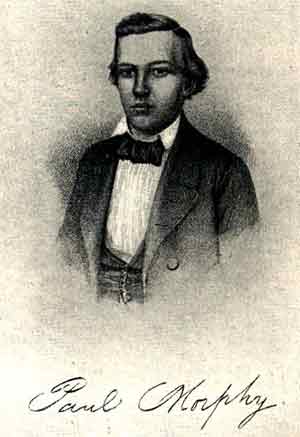 Most of the
remaining years of his life were spent quietly with his family in New
Orleans, where he died in 1884. That chess had something to do with his mild
derangement seems probable. but the exact connection is harder to ascertain.
The most likely explanation of the role that chess played in his mental life
is this: Morphy was troubled by a peculiar dilemma, which has bothered many
other great masters. Eminence in chess was a useless achievement to most of
the people around him. Worse, he was afraid that people thought of him as a
kind of freak, or at best as a kind of unusual gambler who had learned all
the tricks. That is why Morphy always insisted so strongly on his amateur
status. Once when an admirer paid him a compliment by calling him the
professional chess champion of the world, Morphy objected most earnestly on
the grounds that his father had left him $136,472.23 and that he had never
accepted a penny for any chess activities (There is a rumor current that a
girl refused him because she did not want to marry a mere chess player.) Then, Morphy's great goal in life, we have repeatedly been told, was to be a
prominent lawyer and he found that prospective clients gaped at the chess
genius, but could not take the lawyer seriously. He must have reflected on
how different the situation would have been if he had achieved casual
prominence in some other field. Thus the twin delusions that chess was
worthless, and that he could not do anything else, continually increased his
isolation and finally led to loss of balance. Most of the
remaining years of his life were spent quietly with his family in New
Orleans, where he died in 1884. That chess had something to do with his mild
derangement seems probable. but the exact connection is harder to ascertain.
The most likely explanation of the role that chess played in his mental life
is this: Morphy was troubled by a peculiar dilemma, which has bothered many
other great masters. Eminence in chess was a useless achievement to most of
the people around him. Worse, he was afraid that people thought of him as a
kind of freak, or at best as a kind of unusual gambler who had learned all
the tricks. That is why Morphy always insisted so strongly on his amateur
status. Once when an admirer paid him a compliment by calling him the
professional chess champion of the world, Morphy objected most earnestly on
the grounds that his father had left him $136,472.23 and that he had never
accepted a penny for any chess activities (There is a rumor current that a
girl refused him because she did not want to marry a mere chess player.) Then, Morphy's great goal in life, we have repeatedly been told, was to be a
prominent lawyer and he found that prospective clients gaped at the chess
genius, but could not take the lawyer seriously. He must have reflected on
how different the situation would have been if he had achieved casual
prominence in some other field. Thus the twin delusions that chess was
worthless, and that he could not do anything else, continually increased his
isolation and finally led to loss of balance.
While Morphy was still alive,
a curious development occurred. It was obvious to all that he was the most
successful master yet seen. But, not content with such faint praise, his
glorifiers went on to urge that he was the most brilliant genius who had
ever appeared. It was claimed that he had the most marvelous intuition any
mortal was ever granted. That he won his games by combinations of incredible
beauty, that he could have beaten any of his successors with ridiculous
case. In short, Morphy became to millions the most gifted, the most
dazzling, in every respect the greatest chess master of all time. But if we
examine Morphy's record and games critically we cannot justify such
extravaganza. And we are compelled to speak of it as the Morphy myth.
Morphy's games fall into two categories. Of the 403 contained in Maroczy's
book, only 55 are tournament or match games; the remainder are offhand
simultaneous or odds games. Few of the 55 serious games, the only kind
modern masters include in such collections, can by any stretch be called
brilliant. He beat his major rivals because he had a clearer grasp of the
essentials of position play. In fact, Morphy is the first who really
appreciated the logical basis of chess. He could combine as well as anybody,
but he also knew under what circumstances combinations were possible-and in
that respect he was twenty years ahead of his time. Anderssen could attack
brilliantly, but had an inadequate understanding of its positional basis.
Morphy knew not only how to attack, but also when -and that is why he won.
The tragedy is that when others, like Steinitz, who knew when, came along,
Morphy refused to meet them. Even if the myth has been destroyed, Morphy
remains one of the giants of chess history. His meteoric career together
with the freshness and originality of his games will always continue to
inspire all who love chess.
|
|
Paulsen vs. Morphy
It is, frankly, hard to find good Morphy games, comparable to those of,
say, Alekhine, or Lasker.
The difficulty, as we have indicated, is that his opponents made such bad
blunders. The following game, one of his most famous, is typical.
New York, 1857
FOUR KNIGHTS' GAME
Louis Paulsen
Paul Morphy
White Black
1 P-K4
P-K4
2 Kt-KB3
Kt-QB3
3 Kt-B3
Kt-B3
4 B-Kt5
. . . .
An unusual opening at that time.
4 . . . .
B-B4
Nowadays we know that 4 . . . B-Kt5 or
4 . . . . Kt-Q5 is better. We must remember that
Morphy's main objective was always to secure free and easy development.
5 0-0
5 KtxP is not so good here:
5 . . . KtxKt;
6 P-Q4, B-Q2 is satisfactory for Black.
5 . . . .
0-0
6 KtxP!
. . . .
Best,
6 . . . .
R-K1
7 KtxKt
. . . .
Obvious - and bad. 7
Kt-B3! KtxP; 8 P-Q4,
KtxKt; 9 PxKt gives White an advantage.
7 . . . . QPxKt
8 B-B4
. . . .
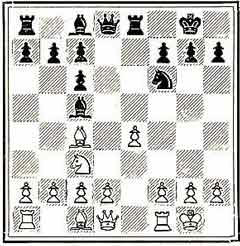
Here the obvious continuation is
8 . . . Kt-Kt5. The move is a natural for an
Anderssen, or any other master whose main concern is the attack. But Morphy
rarely begins an offensive until he has completed his development, a
sufficient indication of the fact that he was a generation ahead of his
contemporaries.
But the present situation is peculiar because it is an exception to the
general rule - 8 . . .
Kt-Kt5! leads to a forced win. On 9 P-KR3, KtxP; 10 RxKt,
BxRch; 11 KxB, Q-Q5ch decides. Best on 8 .
. . Kt-Kt5 is 9 P-Q4, when 9 . . .
BxP; 10 P-KR3, Kt-B3!; 11 B-KKt5, Q-Q3 |
is the simplest way to preserve Black's superiority.
How does it happen that Morphy overlooks a forced win at such an early
stage? The principle of development was such an enormous advance on the
prevailing theory or, more correctly, lack of theory, that its mechanical
application was enough to give him a significant advantage.
7 . . .
P-QKt4
While Morphy always made sure that his pieces were developed properly,
he often showed little concern for his pawn position. The reason, of course,
is that nobody in his day knew how to exploit a weak pawn structure.
It goes without saying that
8 . . . KtxP?? is a blunder:
9 KtxKt, RxKt; 10 BxPch! wins for White.
9 B-K2
KtxP
10 KtxKt
Now 10 B-B3? when KtxP!;
11 RxKt, Q-Q5 is conclusive, for if 12 Q-B1,
QxRch; 13 QxQ,
R-K8ch; etc.
10 . . .
RxKt
11 B-B3
The prelude to a positional blunder which a Rook odds player would not
be guilty of nowadays. After the obvious 11 P-B3 followed by
P-Q4. Whit's game is preferable.
11 . . .
R-R3
12 P-B3?
Ignoring the hole completely.
12. P-Q3 was still good enough for equality.
12 . . .
Q-Q6
Morphy wastes no time - he knows that P-Q4 must be stopped.
13 P-QKt4
White is in a bad way. If 13 R-K1, RxRch; 14 QxR,
BQ2 followed by . . . R-K1 maintains the
pressure.
13 .
. . B-Kt3
14 P-Qr4
The only way he can get any freedom.
14 . . .
PxP
15 QxP
. . .
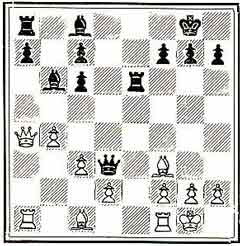
15 . . .
B-Q2
Gives Paulsen a chance to get rid of the bind; perhaps Morphy had the
pretty combination which follows in mind. |
Objectively, however, 15 . . .BKt2 was the proper move since there is no
adequate defense for White.
E.g. 16 R-R2, QR-K1; 17 Q-Q1,
B-R3; or 16 B-Kt2, QR-K1;
17 QR-B1, QxQP, etc. with an easy win in both cases.
16 R-R2?
Loses neatly. After Q-R6 White would have been able to play P-Q4, solving
most his problems.
16 . .
. QR-K1
Threatening . . . QxRch!
17. Q-R6
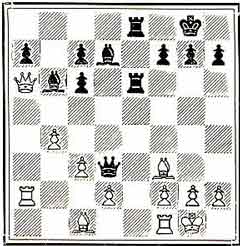
Now he finally tries to liberate himself, but it is too late.
17 . .
.
QxB!!
An elegant conclusion.
18 PxQ
R-Kt3ch
19 K-R1
B-R6
20 R-Q1
On move 20 R-Kt1, RxRch and mate in two
follows. 20 Q-Q3, P-KB4!;
21 Q-B4ch, K-B1! would not have saved him either.
20 .
. .
B-Kt7ch
21 K-Kt1
BxP dis ch
22 K-B1
B-Kt7ch
Almost anything wins here, but the quickest was mate in four
beginning with 22 . . . R-Kt7; 23 Q-Q3 (or
23 QxB, RxRP and mate next) RxBPch
and 25 . . . R-Kt8 mate.
23 K-Kt1
B-R6 dis ch
Morphy chooses to win by material superiority. Instead 23 . .
. B-K5 dis ch again leads to mate in a few:
24 K-B1, B-KB4!; 25 Q-K2,
B-R6ch; 26 K-K1, R-Kt8 mate.
24 K-R1
BxP
25 Q-B1
BxQ
26 RxB
R-K7
This time he does choose the quickest
27 R-R1
R-R3
28 P-Q4
At last! The Bishop is freed in time to resign gracefully.
28 . . .
B-K6
Resigns |
|
|

